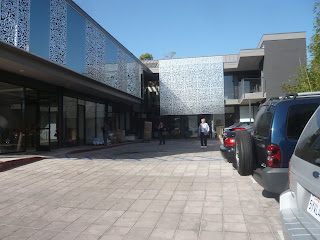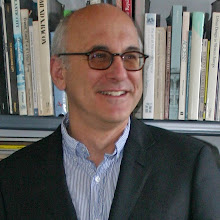A question arises when looking at the common mini-mall. Are they pure building type, in essence a wholly engineered response to a given set of economic imperatives that directly relate the automobile to the consumption of everyday convenience, or do they have the capacity to embody more complex values and aspirations? Certainly most mini-malls are parsimonious in the deployment of detail, symbol and idea, sticking to the tried and true, rarely deviating from the formula of a corner "L" embracing a field of parking.


In Los Angeles at the intersection of Western and 6th, this two-story mini-mall is an engineered exercise in design efficiency. No architectural excess or delight mars its economy of purpose and convenience.
Another way of asking this same question might be, do mini-malls lie outside architectural discourse? Clearly if I really thought this I would not be writing this essay. Yet, one has to be an iconoclast at best and a masochist at worst to pursue the mini-mall as an object of architectural passion (or to desire to design a mini-mall - which I do). Most of them are quite plain if not visually blighting. All the conversations and experiments that mark contemporary architecture may be wasted on a building form that is more often than not prosaic. After all, the real purpose of a mini-mall is to provide a drive-in vessel of convenience, an envelope set in urbanized space to go in and out of quickly and with purpose - a machine to facilitate everyday consumption.
Seeking beauty in the form of a mini-mall raises all sorts of accusations from the architectural crowd. Somewhere between bemusement and anger, I am variously accused of being uninterested, undiscriminating and populist in the sense of being part of the ignorant mob-like crowd. At other times I admit to a sense of perversion. I do have trouble justifying this interest in the basest form of commercial architecture. Do I perhaps too quickly take undue pleasure in the destruction of traditional as well as yet to be realized cityscapes through the unintended promotion of unfettered commercial automobile oriented sprawl? Yet to those who don't believe it possible I tell you there are mini-malls that rise above the merely utilitarian. These mini-malls suggest that the form is still evolving, is still relevant, is still an architectural tool that can be deployed and when deployed reward and enrich everyday life. Three of these mini-centers are encountered in my daily life and they each make an architectural statement of care.
 Beverly Palm Plaza in Beverly Hills, California was designed by Goldman Firth Architects and completed about eight years ago.
Beverly Palm Plaza in Beverly Hills, California was designed by Goldman Firth Architects and completed about eight years ago. At Beverly Palm Plaza the sky is always mediated by the architectural forms, creating a connection between the built and natural environments.
At Beverly Palm Plaza the sky is always mediated by the architectural forms, creating a connection between the built and natural environments.At the ground plane of Beverly Palm Plaza flax plants create a vertical green buffer between the automobiles in the street facing parking lot and the surrounding sidewalks. The surface of the parking lot is made up of simple concrete pavers, providing a rich surface to walk across to and from your car. In the corner, a small round seating area creates a welcome respite and invites one to linger a bit after dropping off the laundry. Every detail is thought through, an educated hand and eye shaped every proportion and choice of material. Beverly Palm Plaza demonstrates that it is possible to create a mini-oasis along a busy Los Angeles boulevard, a moment of architectural uplift in the course of a busy day.
The second example of an architecturally focused mini-mall is just a block to the east of Beverly Palm Plaza along Olympic Boulevard in this same city. The fact that two such examples exist so close to each other in one city is also no doubt a testament to the rigor of the Beverly Hills design review process, but that is a topic for another time.
Doheny Plaza, the mini-mall at the northeast corner of Olympic Boulevard and Doheny Drive, was designed by Kanner Architects and completed in 1995. Still fresh looking almost fifteen years after its completion, this center is unusual in that the parking is tucked behind the two-story structure, sheltered by a twenty foot overhang supported by tension rods. According to the architect this is a structural reference to a tension rod supported canopy that graced a previous gas station that stood at the site. Regardless of the resulting sidewalk hugging character of the building and the sense that it might be more of a taxpayer block then a mini-mall, the small footprint occupied by this building in contrast to the generous area left for surface parking clearly keeps this building within the commercial corner genre. Yet here the type evolves, providing sidewalk friendly storefronts and a second floor that clearly suggests use as office space as opposed to the second tier and lower rent retail found in too many centers. The diagram of this center is wrapped in a crisp modernism that at once evokes Le Corbusier, Oscar Niemeyer and
Arquitectonica. However, the expressiveness of the structural detailing at both the storefronts and at the overhang make the architecture specific to the seismic forces of Los Angeles and surrounds. Doheny Plaza tweaks the typical mini-mall diagram by putting the cars in the back but never strays so far from basics as to become inconvenient for its vehicle bound patrons.
The last example is again a rehabilitated building, in this case a repurposed mini-mall. Designed by architects Rios Clemente Hale for their own offices with attendant ground floor retail space for their product business Not Neutral, this redesigned center sits just south of the intersection of Melrose Avenue and Larchmont Boulevard.
 Rios Clemente Hale redesigned and repurposed an existing mini-mall in the Larchmont area of Los Angeles, transforming it into a center for their own offices and attendant retail space.
Rios Clemente Hale redesigned and repurposed an existing mini-mall in the Larchmont area of Los Angeles, transforming it into a center for their own offices and attendant retail space.What was once an undistinguished center has had its walls ripped off and replaced with a visually sophisticated metal and glass wall. Transparent glass planes reveal interior activities yet at the same time allow for a sense of privacy when interupted by attached and integral aluminum decorative screens. Like Beverly Palm Plaza, concrete pavers at the ground plane create a simple yet textured plaza that is at once rich and welcoming. The exterior space is allowed to bleed into the interiors of the architect's offices, suffusing the entry with a sense of layering, light and the delightful confusion of reflections.
 The interior of the Rios Clemente Hale office merges inside and outside space, a trait rarely characteristic of a mini-mall.
The interior of the Rios Clemente Hale office merges inside and outside space, a trait rarely characteristic of a mini-mall.These are all of course designed phenomenon that transcend the utility that is presumed to be inherent to the mini-mall type.
In each of these three cases, and I keep collecting more examples, the presence of Architecture infuses a spirit of generosity into a form of built pattern that is assumed to be impervious to delight. In the hands of a capable architect of course anything is possible but imagine if you will a city in which the prosaic, indeed the typically banal mini-mall, is always infused with beauty. Convenience is celebrated as opposed to tolerated. Diagrams, mini-mall diagrams in particular, while not completely forgiven as a type that can foster mindless vehicle oriented consumption and sprawl, are also seen to be in these examples opportunities for the expression of architectural ambition and everyday delight.


2 comments:
Hi John. Thank you for writing about minimalls. I also want to remind you to correct the spelling of "Arcitectural"(the one above the picture of Biscuit). See you. TT
Thanks for the word check Takako. Let me know if you want to correspond.
Post a Comment